Spotted Towhee – Passeriformes Emberizidae Pipilo erythrophthalmus
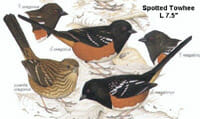 |
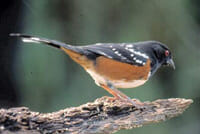 |
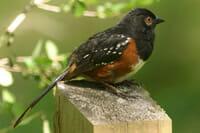 |
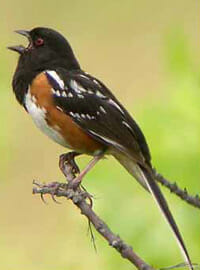 |
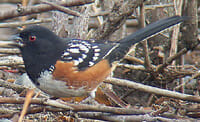 |
Identification & Description:
• Medium-sized songbird.
• Conical bill
• Red eye
• Rusty sides
• White belly
• Buffy undertail coverts
• Chest and belly white.
• Sides and flanks rufous.
• White wing bars and spots on back
• Long tail with white outer tail feathers
• Male has black head, back, wings and tail-paler in female
• Juvenile (Summer) heavily streaked, brown above and buffy below
• Frequently feeds on the ground where it noisily scratches for food
• Formerly conspecific with Eastern Towhee
• Size: 17-21 cm (7-8 in)
• Weight: 33-49 g (1.16-1.73 ounces)
Similar species:
The Eastern Towhee is similar to the Spotted Towhee but lacks wing bars and white spots on the back.
Life History Groupings
• Migration Status: Short distance migrant
• Breeding Habitat: Successional-scrub
• Nest Location: Ground-low nesting
• Nest Type: Open-cup
• Length of Incubation: 12-13? days
• Days to Fledge: 10-12
• Number of Broods: 2, occasionally 3 in south
• Diet:
Mostly: Nuts, Seeds & Fruit
Lesser Quantities of: Insects
Facts
• Watch a Spotted Towhee feeding on the ground; you’ll probably observe its two-footed, backwards-scratching hop. This “double-scratching” is used by a number of towhee and sparrow species to unearth the seeds and small invertebrates they feed on. One Spotted Towhee with an unusable, injured foot was observed hopping and scratching with one foot.
• The Spotted Towhee hybridizes with the Eastern Towhee where their ranges meet in the Great Plains. It also hybridizes with the Collared Towhee where their ranges meet in Mexico.
• Twenty-one different subspecies of Spotted Towhee are recognized, three on islands off the Pacific Coast. The race from Isla Guadalupe off Baja California is extinct. The small race on the island of Socorro off Baja California and the larger race on Santa Catalina Island off southern California are vulnerable to extinction because of their restricted ranges. The Santa Catalina form formerly was found on San Clemente Island, but disappeared from there by 1976.
Other Names
Tohi tacheté (French)
Chouís, Toquí de Socorro (Spanish)
The spotted towhee is a member of the family Emberizidae, in the order Passeriformes, and is classified as Pipilo maculatus.
Spotted Towhee, common name for a songbird found throughout the western United States into southern Canada and northern Mexico. It lives in a variety of habitats including open woods and chaparral. Since it lives, feeds, and nests in dense underbrush, the spotted towhee is more often heard than seen. Until 1995 the spotted towhee was considered a race of the rufous-sided towhee. In light of recent DNA analyses and a reexamination of differences in songs and morphology (the birds’ form and structure), scientists have split the rufous-sided towhee into two populations: the spotted towhee and the eastern towhee.
The spotted towhee measures 18 to 21 cm (7.0 to 8.5 in) in length. The male has red eyes; a black head, throat, back, and tail; reddish sides; and a white belly, with large white patches on the outer tips of his long rounded tail. The back and wings are spotted with white and have two white bars. The female has similar plumage with more muted colors. Birds in their first year, or juveniles, start off all brown, and later develop a plumage similar to that of the female.
The spotted towhee gathers food on or near the ground, foraging noisily in leaf litter by jumping forward and scratching back with its long toes. During the spring, as it raises its young, it feeds on insects, including beetles, caterpillars, and ants, as well as snails, spiders, and millipedes. During the fall and winter, seeds and berries constitute a large part of its diet.
The male defends his nesting area by singing. He courts the female with a softer version of his territorial song, and will sometimes chase her or display the white spots on his tail feathers. The female builds the nest on or very near the ground under a shrub. The nest is an open cup of twigs and weeds lined with finer material. The female incubates, or warms, the three or four cream colored eggs by sitting on them for 12 or 13 days until they hatch. While the female is caring for the eggs, the male feeds her, and both parents help feed the newly hatched young. The young are able to fly about 12 days after hatching. In good conditions, the spotted towhee will raise two batches, or broods, of young in one breeding season.